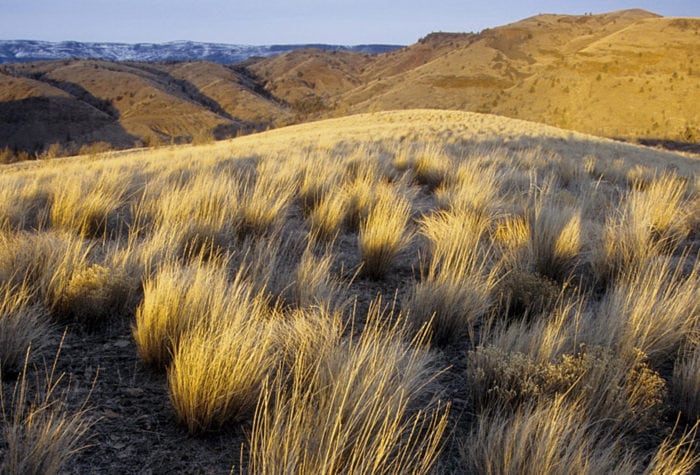Beech Creek Juniper Removal July 12-15
Susie Defazio
| Organizer: Jeremy Austin
Start Date: 7/12/2018 End Date: 7/15/2018 Region: John Day River Basin Difficulty Rating: 3 out of 5 Maximum Group Size: 15 participants |
About the place
Beech Creek Ranch was purchased by the Burns Paiute Tribe in 2015. This ranch, which is now managed as wildlife habitat, is within the John Day River basin and comprises 2,400 acres with 6 miles of anadromous fish bearing creek and riparian area, 160 acres of hay meadows, and the balance in juniper and bunch grass prairie.
The Burns Paiute Natural Resource Department’s preliminary goals for the property are: restoration of the riparian vegetative corridor, restoration of fish passage and in-stream habitat, conversion of degraded rangeland to productive wildlife habitat, improvement of irrigation efficiency and meadowland hay productivity, and development and preservation of ranch infrastructure. ONDA has agreed to partner with the Tribe to accomplish important restoration work that supports their objectives over the next four years.
About the stewardship work
 Western Juniper has been expanding throughout much of its range. The rapid increase has many land managers concerned about the health of the sagebrush-grassland habitat because juniper can displace many of the shrubs and grasses that provide forage to wildlife and at-risk species such as sage-grouse. Junipers also cause problems for many watersheds because they require large amounts of water as compared to other shrubs or grasses.
Western Juniper has been expanding throughout much of its range. The rapid increase has many land managers concerned about the health of the sagebrush-grassland habitat because juniper can displace many of the shrubs and grasses that provide forage to wildlife and at-risk species such as sage-grouse. Junipers also cause problems for many watersheds because they require large amounts of water as compared to other shrubs or grasses.
ONDA volunteers will spend the week removing the recent increase in young junipers near the riparian stretches of the ranch. The work will involve using loppers and saws to cut the junipers at the base of the tree. It can be difficult, hot, scratchy, and challenging, but it feels good to look back at the end of the day and see a healthier rangeland.
Trip timeline
- Thursday, July 12, (5-7 p.m.): Volunteers should plan to arrive in the evening with enough time to set up, meet others at camp, and spend some time talking about the weekend ahead.
- Friday, July 13: After breakfast, we will walk to the worksite on Beech Creek to begin our first day of juniper removal. Volunteers should plan to be out all day and be prepared for a full day of walking, kneeling and doing physical work in weather that could be hot and dry.
- Saturday, July 14: Another day of juniper work. Plan to be out from about 8 a.m. to 4 p.m.
- Sunday, July 15: After breakfast the group will be free to head home or spend some additional time exploring the expansive property that we will be working on.
Camp
We will be car camping in an open meadow near a ranch house with access to running water and bathroom facilities. Volunteers should plan to bring all necessary camping equipment to spend three nights outside.
Difficulty
The work will require walking approximately two miles each day, kneeling down to cut junipers, and carrying a daypack with food, water and ample clothing to stay warm and dry in variable conditions.
Participant responsibilities
Participants are responsible for their own food and camping gear as well as transportation to and from the trip (don’t forget your camp chair!). ONDA will bring water, but it is a good idea to supplement our supply with a few gallons from home. In the event of sunny and hot weather, please bring up to four liters of water capacity for the day, and consider an electrolyte replacement drink or mix to help you stay hydrated. Sturdy off-trail ankle-high boots, long pants, a long sleeve shirt (a lightweight sun shirt is a great option), and eye protection are required for this trip (sunglasses or prescription eyeglasses are suitable eye protection). Participants should be prepared to be away from camp all day and bring a daypack for lunch, snacks, and water.
Gear provided
ONDA will provide tools for the work, work gloves, and sunscreen. We will bring some group camping equipment (shade tent, tables for cooking, wash bins for kitchen cleanup, a privy), some potable water, expert leadership, and we can talk about some of the important restoration projects within the John Day River basin.
Registration
An ONDA registration application and medical form are required for this trip.
Apply Now
You only need to fill this form out once per year and can join additional trips this year by e-mailing the trip leader directly. You will receive a confirmation e-mail within 10 working days of submitting your form. The confirmation e-mail will provide information regarding which trips you are on the “participant list” for, and which trips are full, and therefore you have been placed on the “wait list.”
Six weeks before the start of the trip, the trip leader will send out an RSVP to make sure everyone is still able to participate. Based on RSVPs, open spaces will be backfilled with people from the waitlist.
Three weeks before the trip start date, registered and confirmed participants will receive driving instructions, maps, car-pooling options, and additional information in an email sent by the trip leader
If you have any questions in the meantime, please don’t hesitate to contact the trip leader.
This trip will be led by Jeremy Austin. If you have questions, you can contact him at (541) 330-2638 or email jeremy@onda.org.
Restoring Desert Ecosystems
ONDA works with partners, communities and the public to improve habitat quality, create healthy ecosystems, sustain clean water and support biodiversity in the high desert’s most ecologically important areas. What […]
Read More